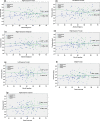Cognitive impairment in schizophrenia: relationships with cortical thickness in fronto-temporal regions, and dissociability from symptom severity
- PMID: 33737508
- PMCID: PMC7973472
- DOI: 10.1038/s41537-021-00149-0
Cognitive impairment in schizophrenia: relationships with cortical thickness in fronto-temporal regions, and dissociability from symptom severity
Abstract
Cognitive impairments are a core and persistent characteristic of schizophrenia with implications for daily functioning. These show only limited response to antipsychotic treatment and their neural basis is not well characterised. Previous studies point to relationships between cortical thickness and cognitive performance in fronto-temporal brain regions in schizophrenia patients (SZH). There is also evidence that these relationships might be independent of symptom severity, suggesting dissociable disease processes. We set out to explore these possibilities in a sample of 70 SZH and 72 age and gender-matched healthy controls (provided by the Center of Biomedical Research Excellence (COBRE)). Cortical thickness within fronto-temporal regions implicated by previous work was considered in relation to performance across various cognitive domains (from the MATRICS Cognitive Battery). Compared to controls, SZH had thinner cortices across most fronto-temporal regions and significantly lower performance on all cognitive domains. Robust relationships with cortical thickness were found: visual learning and attention performance correlated with bilateral superior and middle frontal thickness in SZH only. Correlations between attention performance and right transverse temporal thickness were also specific to SZH. Findings point to the importance of these regions for cognitive performance in SZH, possibly reflecting compensatory processes and/or aberrant connectivity. No links to symptom severity were observed in these regions, suggesting these relationships are dissociable from underlying psychotic symptomology. Findings enhance understanding of the brain structural underpinnings and possible aetiology of cognitive impairment in SZH.
Conflict of interest statement
The authors declare no competing interests.
Figures

References
Grants and funding
LinkOut - more resources
Full Text Sources
Other Literature Sources

